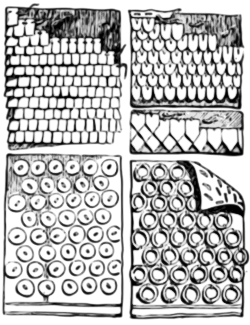Scale armour
Scale armour is an early form of armour consisting of many individual small armour scales (plates) of various shapes attached to each other and to a backing of cloth or leather in overlapping rows.[1] Scale armour was worn by warriors of many different cultures as well as their horses. The material used to make the scales varied and included bronze, iron, rawhide, leather, cuir bouilli, seeds, horn, pangolin scales and, in ancient China, paper. The variations are primarily the result of material availability.
Types of scale armour
Scale armour is armour in which the individual scales are sewn or laced to a backing by one or more edges and arranged in overlapping rows resembling the scales of a fish/reptile or roofing tiles.[2] The scales are usually assembled and strapped by lacing or rivets. Lorica squamata is an ancient Roman armour of this type[1]
Other types of armour made from individual scales but constructed in a different manner have their own separate names, such as lamellar armour where the individual scales are perforated on several or all edges and lashed tightly to each other in straight ridged rows and do not need to be attached to a backing. The Romans also had a variant called lorica plumata in which the scales were attached to mail.[3]
Historical information
Horses covered with scale armour are mentioned in the ancient Chinese book of poetry Shi Jing, which is several thousand years old.[4] Scale armour is not of frequent occurrence on the grave monuments of the German frontier. On two tombstones of the Sertorii at Verona (one that of a centurion, the other that of a standard-bearer) both figures are represented wearing a tunic of scale armour which covers the shoulders and comes down below the belt. The Carnuntum monument of Calidius (a work of the middle of the first century) shows also a scaled tunic of a centurion. Again, in the collection of marble portrait-busts from the great Gallo-Roman villa of Chiragan near Toulouse, the Emperors Antoninus Pius and Severus both appear wearing corselets of scale armour.
Scythians
The Scythians' horse warriors appear to have used scale or possibly lamellar armour, evident both from contemporary illustrations and burial finds in the Kurgans. The armour was made from small plates of iron or bronze. Unique to the Scythians, about 20% of the females found in graves were dressed for war, some including armour, which may have inspired the Greek tales of Amazons.[5]
Due to the semi-rigid nature of the armour, the Scythian variety was made as breast- and back-plates, with separate shoulder pieces. Some finds indicate partial armour, where a leather shirt or similar garment have sewn-on scales in places, particularly around the neck and upper chest.
Roman scale armour
The individual scales used to construct Roman armour are called squamae[6] or squama[7] During Roman times, scale armour (lorica squamata) was a popular alternative to mail (lorica hamata) as it offered better protection against bludgeoning. It was also widely used in Middle Eastern empires, such as Persia and Byzantium. In these areas, scales were commonly dished (that is with a bowl effect from a depression being hammered into a flat piece of metal) in order to benefit from the extra protection offered by a rounded scale.
According to the statement of Herodotus, the ancient Persians wore tunics with sleeves of diverse colours, having upon them iron scales of the shape of fish-scales; and this comparison leaves no doubt that scale armour, and not mail, is meant.[8]
Japanese scale armour
Japanese (samurai) individual scales are called kozane.[9] Japanese scale armour constructed from fish type scales (gyorin kozane) were reportedly constructed in Japan as far back as the Fujiwara period (11th century). "A primitive type of Japanese harness, the single laminae being of boiled leather, cut and beaten into pieces shaped like fish-scales."[10]
Comparison with other armour types
Scale armour offers better and more solid protection from piercing and blunt attacks than chainmail.[11] It is also cheaper to produce, but it is not as flexible and does not offer the same amount of coverage. Forms other than brigandine and coat of plates were uncommon in medieval Europe, but scale and lamellar remained popular elsewhere.
Modern forms of scale armour are sometimes worn for decorative or LARP purposes, and may be made from materials such as steel, aluminium, or even titanium.
A similar type of modern personal armour is Dragon Skin body armour, which uses ballistic fabric and high-impact resistant ceramic plates to protect against pistol and rifle fire. However, its "scales" are not exposed.
Gallery of scale armour
 Scythian warrior in bronze scale armour
Scythian warrior in bronze scale armour Examples of early armour construction. The top two sections are examples of scale armour.
Examples of early armour construction. The top two sections are examples of scale armour. Riveted-laced scale armour. Note: the tops are laced to backing, the centres are loosely riveted. (East-Europe, Kievan Rus and Byzantium)
Riveted-laced scale armour. Note: the tops are laced to backing, the centres are loosely riveted. (East-Europe, Kievan Rus and Byzantium)- Japanese fishscale armour "gyorin kozane" from a helmet neck guard "kabuto shikoro" made from hardened leather.
 Korean armour made of tin scale (錫鱗甲), displayed at the Danghangpo Tourist Resort, site of the Battle of Danghangpo.
Korean armour made of tin scale (錫鱗甲), displayed at the Danghangpo Tourist Resort, site of the Battle of Danghangpo..jpg) Historical re-enactment of a Sassanid era cataphract.
Historical re-enactment of a Sassanid era cataphract.
References
| Wikimedia Commons has media related to Scale armour. |
- 1 2 Armed Batavians: Use and Significance of Weaponry and Horse Gear from Non-military Contexts in the Rhine Delta (50 Bc to Ad 450), Author Johan Nicolay, Publisher Amsterdam University Press, 2008, ISBN 90-5356-253-2, ISBN 978-90-5356-253-6
- ↑ Publication: Anthropological series, Volume 13, (Field Museum of Natural History : 1909), Author Field Museum of Natural History, Publisher The Museum, 1913, Original from Harvard University P.258
- ↑ Roman military equipment: from the Punic Wars to the fall of Rome, M. C. Bishop, J. C. Coulston, Oxbow Books, 2006 – History P.95
- ↑ Notes on turquois in the East, Volume 13, Issues 1-2, (Google eBook), Berthold Laufer, s.n., 1914 P.306
- ↑ Anthony, David W. (2007). The Horse, the Wheel, and Language: How Bronze-Age Riders from the Eurasian Steppes Shaped the Modern World. Princeton University Press. ISBN 0-691-05887-3.
- ↑ A new and complete dictionary of arts and sciences, Volume 4 P.3046
- ↑ A new Latin-English school-lexicon: on the basis of the Latin-German lexicon of Dr. C. F. Ingerslev, George Richard Crooks, Christian Frederik Ingersley, Alexander Jacob Schem, J.B. Lippincott, 1861 P.859
- ↑ Berthold Laufer (1914), Chinese Clay Figures, p. 239 OCLC 2301581
- ↑ The Watanabe Art Museum Samurai Armour Collection Volume I ~ Kabuto & Mengu, Trevor Absolon, Toraba Samurai Art, 2011 P.70
- ↑ Chinese clay figures: Prolegomena on the history of defensive armor, Part 1, Berthold Laufer, Field Museum of Natural History, 1914 P.196
- ↑ Goldman, Norma.“Reconstructing Roman Clothing,” in The World of Roman Costume. Eds. Judith Lynn Sebesta and Larissa Bonfante (Madison, Wisc.: University of Wisconsin Press, 1994): 213–237.